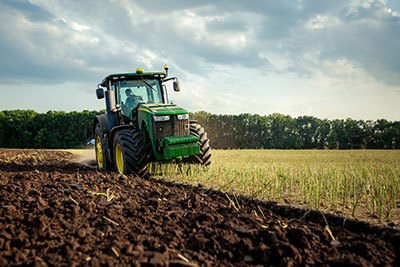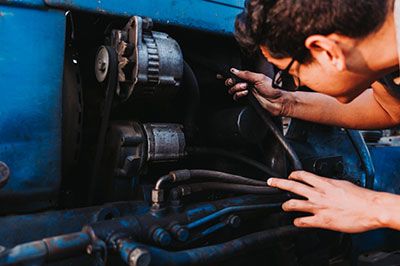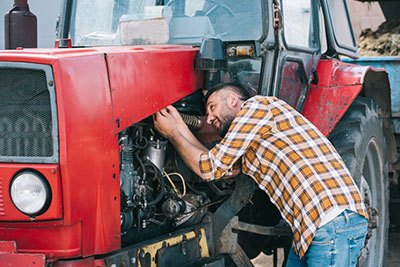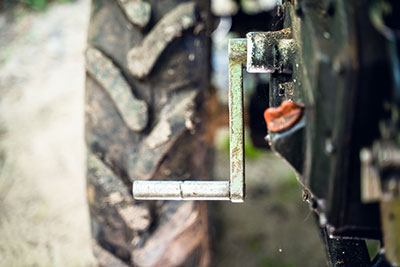Do you own a tractor and struggle to diagnose why it stops working? If so, then this guide is for you. If your tractor won’t start or has stalled recently and no matter how much tinkering you do, nothing seems to get it going again, worry not!
We’re here to help provide some insight into the technical side of things that may be affecting it.
In this article, we will go over troubleshooting techniques on why your tractor won’t start and what are the best solutions if something isn’t working properly with your machine.
Take away key points:
- Multiple factors, such as a lever, transmission issues, alternator, gas or diesel caps, blown fuse, gear selector, etc. might cause delays in starting the tractors
- Ensure you know the exact problem to solve it either by yourself or with a mechanic
- Read our guide to detect the issue and take the steps to solve it
Table of Contents
- Common problems & solutions when a tractor won’t start: Don’t panic!
- FAQs
- Summary
Common problems & solutions when a tractor won’t start: Don’t panic!
If you’re not sure who to contact and what to do when your tractor cannot start properly, and has other issues, don’t worry.
All these issues are fixable, so you can solve common issues without a headache. Read on for the best guidelines to make your tractor work well.
Why tractors aren’t working? Common problems

If your tractor cannot start, it can be a frustrating experience. There are several possible causes for this problem, such as a faulty cold start system, dirty fuel injectors, or a faulty ignition switch.
Check the safety switches first, as these are often the cause of the issue. Additionally, you should make sure that the spark plug points are in good condition and that the electrical system is sending a spark to the igniter and the ignition switch.
Finally, inspect any ignition wiring for damage or lose wires. Taking these steps can help you get your tractor running again quickly and safely once you manage the ignition switch.
My tractor isn’t working: Checking safety switches
To make sure your tractor is running properly, it is important to check the four safety switches that are usually located on the tractor.
The first switch is usually found underneath the seat and newer models may have this switch built into the seat itself. This switch is designed to shut off the engine if the operator falls off of the tractor.
If something has been stowed behind your seat and moved during transit, this could prevent the seat from reaching down onto the switch and, in turn, prevent the engine from starting.
To check the remaining three safety switches, you’ll need to take a few steps.
First, make sure the tractor is on flat and level ground with block chocking the wheels. Remove the keys from the ignition and then get someone to join you. The other person should sit in the driver’s seat as they will be moving levers throughout this process into the tractor start position.
Look for any debris or sticks that might be stuck in the mechanism or if anything could have shifted out of place while mowing. It is also possible that some of these switches may just be out of alignment and can easily be adjusted accordingly.
1. Manage the PTO switch first
Get your helper to move the Power Take-Off (PTO) engagement lever back and forth so that you can see where the switch is mounted on a bracket beneath the tractor.
Watching for potential finger pinching, check if any wedged objects could be preventing the ignition switch from starting. If there is an engaged PTO, this will keep the engine from starting until the switch is turned off.
2. Second, adjust the transmission switch
Different possibilities exist depending on the type of transmission. If you have a gear drive, the switch may be located on the shuttle lever, range lever, or under the gear lever. Have your friend move these levers to check for the switch location.
Alternatively, on hydrostatic trans, the tractor will only start in neutral and the switch can often be found inside the transmission. Potentially a piece of debris or a stick may have jiggled off one of its wires. It will cause the engine block and the switch will not start.
3. Third, manage the brake safety switch
Before getting off your machine, ensure the emergency brakes are set to avoid your tractor from rolling over you. Your friend can push down on the brakes and engage the permanent brake to locate the safety switch that may be causing the issue. This way, you won’t need to visit the dealer.
How do diesel engines work?
A diesel tractor engine is an internal combustion engine that generates power by igniting fuel within its cylinders. The piston then moves to create the forces needed to propel the diesel tractor. This includes four steps: intake, compression, ignition, and exhaust.
During combustion, the air in the cylinders needs to be compressed and heated until it is hot enough for the diesel fuel to ignite immediately when injected. Then, exhaust fumes are released into the air and away from the diesel tractor engine.
Unlike gasoline engines, diesel tractors do not need spark plugs or a carburetor as these components are not required for their operation. Therefore, we can confidently exclude any issues related to those parts when diagnosing your tractor’s problem.
Why isn’t my diesel engine starting?

There are several potential causes why your diesel tractor won’t work well. These include:
– a dead battery,
– clogged fuel filter or lines,
– broken or damaged mechanical parts,
– an overheated engine,
– contaminated diesel fuel,
– a jammed fuel injection pump, an empty fuel tank,
– cold outdoor temperatures,
– air in the fuel lines.
Inspecting and ruling out these possibilities can help you get your engine started again quickly and safely.
How to fix the tractor that won’t work? A step-by-step procedure
Refer to the troubleshooting guide below to solve the issues with your diesel tractors.
1. Examine your diesel fuel filter
When troubleshooting a diesel engine that won’t start, the first thing to do is check the fuel filter for clogs. If the fuel system is dirty and full of debris, it can cause a blockage in fuel level getting to your engine.
Make sure to clean or replace the filter and inspect your fuel system lines and the fuel shutoff valve, as they can also become clogged, just like the fuel filter. Doing these tasks can help you get your tractor started quickly again.
2. Test your tractor battery
If your diesel engine won’t start and you only hear a ‘clicking’ sound, then your battery may be completely dead. Clean the battery’s posts with an abrasive material, dry them off, and reattach the battery cables in the order of POSITIVE (+) and then NEGATIVE (-) on battery terminals.
If this doesn’t work, inspect your battery voltage and cables for any signs of leaking, swelling, or bloating. All of these battery problems could signify that your battery has died.
You can also visit a mechanic and see if they can test it for life. Some mechanics offer this service for free and if the battery is the main issue, replace it for a quick fix.
3. Fill the fuel tank
If your diesel engine isn’t starting, make sure you check the fuel tank for the level of fuel. It may be the case that you’ve run out of fuel and need to refill the tank.
However, once a diesel engine runs out of fuel you can’t just fill it up and start again – you’ll need to prime the engine with fuel before it will work again. Follow these steps:
– Locate the fuel primer pump and bleed screw;
– Loosen the bleed screw;
– Pump the fuel primer for 5-10 minutes until fuel comes out of the bleed screw;
– Tighten the bleed screw and replace the fuel pump;
– Attempt to start the engine; if after 10-15 seconds it doesn’t start, repeat these steps.
4. Cool the tractor engine

To determine if your diesel engine is not starting due to overheating, check your cooling system and coolant levels. Inspect the radiator cap and fins for dirt and use an air compressor to blow dirt off. Test your thermometer by removing it from the machine and using it to measure boiling water on your stove.
Check your radiator hoses for damage – a professional should be brought in to diagnose this issue. Test the water pump and cooling fan as both can cause your engine to overheat.
5. Inspect the fuel for contamination
If your tractor doesn’t start, a common cause may be contaminated diesel fuel. Check the fuel in your tank for gasoline traces and if present, flush it out and refill with diesel fuel.
Additionally, check stored diesel fuel that may have become contaminated by microbes over time as this can also prevent your tractor from starting and losing its power.
6. Inspect the cold temperatures
For diesel engines, cold weather can bring a range of issues. The engine oil can thicken and cause drag on the engine, meaning it won’t start.
Check the dipstick for globby, gunky oil – you may need an oil change with winterized oil to get things going again. The cold can also affect your battery, lowering its output and necessitating a jumpstart.
Additionally, diesel fuel changes at 40°F (4.4°C) or below due to the formation of wax crystals that can block the water/fuel separator. To remedy this issue, move the tractor to a warm garage so the fuel can be brought up to temperature and dissolve any blockages.
7. Examine the air filter & air in the fuel lines
For a diesel engine to run, fuel, air, and compression (or heat) are needed. If there is air in the fuel lines, it will prevent the flow of fuel to the engine and you may need to bleed these lines. To do this:
– Turn off the fuel valve
– Clean the external housing of the fuel filter
– Install a new fuel element and gaskets with added oil for a secure seal
– Open the bleed plug closest to the tank
– Fully open the fuel supply valve
– Locate and pump the prime pump attached to the machine for 5-10 minutes until bubbles free fuel comes out of the bleed plug
– Close this bleed plug and move to next closest one
– Continue through all plugs in the system
– Close all plugs securely
– Attempt to start the engine
– Retry these steps if the engine doesn’t start.
8. Insect the fuel injection pump
The fuel injection pump plays a key role in diesel engines and, if stuck in the open or closed position, can prevent the engine from starting. If it does start, it will likely stall out or lack power when under load or going uphill.
If this is the case with your machine, take it to a professional mechanic. Fuel injection pumps are difficult to work on at home and any DIY attempts could lead to higher costs in the long run. So, the tractor may have issues for a long period.
Additional reasons your tractors won’t work
Here are some of the extra causes your machines won’t start.
1. The mechanical part is damaged beyond repair
Some parts of your engine may be malfunctioning and, if so, it requires a professional mechanic to solve it. Or, if you have to purchase the right part yourself, you can identify the issue.
2. Glow plugs
Glow plugs are used to aid in starting diesel engines in cold weather, with filaments that heat the air in the engine’s cylinders so fuel can combust. Usually, there is one glow plug per cylinder, though some may have up to 10. If one fails, it won’t affect the performance of your tractor too much but if two or three fail then your tractor might be difficult to start or not start at all.
To check if yours are working, leave them installed in the engine and disconnect their wires and jumper cables. Then, use a test light connected to the POSITIVE (+) terminal on your battery and touch it to each wire – if it glows then they’re okay, if not, you must replace them.
3. Fuel caps are creating a vacuum in the tractor engine
When running, diesel is pumped from the fuel tank to the engine’s cylinders; this process creates a vacuum in the tank which needs to be equalized by the entry of air.
To prevent dirt and debris from entering, diesel fuel caps have vents that can become blocked with dirt in the air. This will stop air from replacing the fuel pump, leaving the tank, and creating a “vacuum” in the engine. It prevents it from starting.
To fix this, try cleaning or replacing your fuel cap – just be sure to get a diesel cap with vents instead of a regular gas cap.
Calling a professional
If you haven’t been able to fix the issue yourself, it might be time to call in a professional mechanic. This can be expensive but they are well-equipped and experienced enough to identify and solve the problem quickly.
If you’re not confident working on large machinery or feel uncomfortable doing so, it’s best to err on the side of caution and get an expert opinion.
FAQs
Why will my diesel tractor not turn over?
If your diesel tractor won’t start, the most likely cause is a dirty fuel filter.
The filter may be clogged, preventing fuel from traveling to the engine. Other possible causes include a transmission gearshift lever that is not in the correct position, an engine throttle lever that is not pushed forward, or a lack of fuel in the tank.
You should also check for loose or corroded wires and connections, as well as faulty starters. If you have ruled out all of these potential causes, then it may be time to take your tractor to a professional mechanic for further diagnosis.

Why won’t my tractor turn over or click?
It could be due to a drained battery, a faulty starter, or a problem with the electrical system.
If the battery is drained, you can try charging it and then attempting to start the tractor again. If that doesn’t work, you may need to check the starter for any signs of damage or wear and tear.
Lastly, if the electrical system is having issues, you should inspect all of its components and connections for any signs of damage or corrosion.
What is the first thing to check if a lawn mower won’t start?
If a lawn mower won’t start, the first thing to check is the spark plug. If it is loose, dirty, or disconnected, it needs to be checked out, cleaned off debris, and re-connected and tightened.
Additionally, a dirty air filter can also prevent a mower from starting and should be checked as well.
Summary
Without a functioning tractor, working on the farm can become a seemingly insurmountable task. Thankfully, if you know what could be wrong with the tractor, you can take the necessary steps to fix it.
Invest some time into researching what makes tractors run – after all, happy tractors make for happy farmers!
